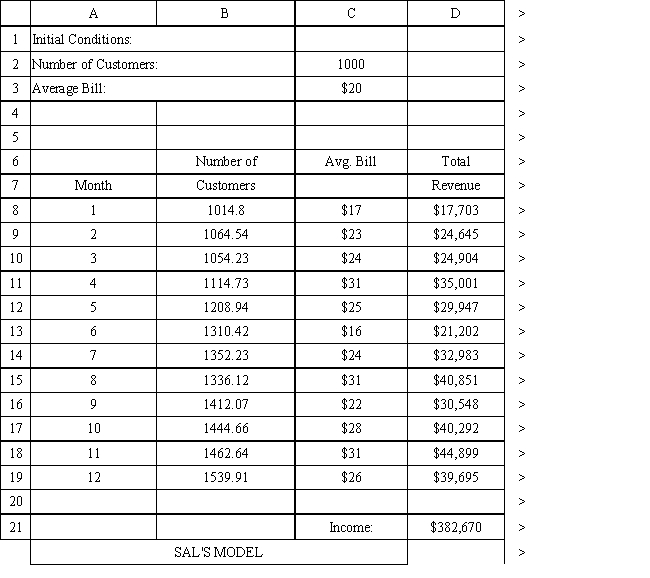Exhibit 12.5
The following questions use the information below.
The owner of Sal's Italian Restaurant wants to study the growth of his business using simulation. He is interested in simulating the number of customers and the amount ordered by customers each month. He currently serves 1000 customers per month and feels this can vary uniformly between a decrease of as much as 5% and an increase of up to 9%. The bill for each customer is a normally distributed random variable with a mean of $20 and a standard deviation of $5. The average order has been increasing steadily over the years and the owner expects the mean order will increase by 2% per month. You have created the following spreadsheet to simulate the problem. 

-A simulation model was replicated 100 times yielding a mean of 82.59 with variance of 17.66. Of the 100 replications, 11 replications yielded an outcome over a value of 100. The 95% confidence interval of the mean is the interval (81.77, 83.41). Of the 100 simulation outcomes, 65 outcomes failed to fall within this interval. What is wrong with the confidence interval?
Definitions:
Negative Thinking
A cognitive pattern where individuals consistently anticipate the worst possible outcomes or view situations and experiences in a pessimistic light.
Happy Activities
Activities that elicit joy, satisfaction, and positive emotional states in individuals.
Cognitive Therapy
A form of psychotherapy that seeks to alleviate psychological stresses by correcting faulty conceptions and self-signals.
Systematic Desensitization
A behavioral therapy technique used to treat phobias and other behavior disorders through controlled exposure to the stimuli causing the disorder, combined with relaxation techniques to reduce anxiety.
Q30: Why does the GRG algorithm not provide
Q31: How much must the objective function coefficient
Q32: In the Kendall notation M/G/4, the number
Q38: What goodness-of-fit measure is commonly used to
Q47: Based on the radar chart of raw
Q73: A dietician wants to formulate a low
Q75: Decision Analysis techniques provide modeling techniques to
Q80: In classification techniques the dependent variable is<br>A)
Q107: In stationary time series there is no
Q118: Refer to Exhibit 10.2. What number of